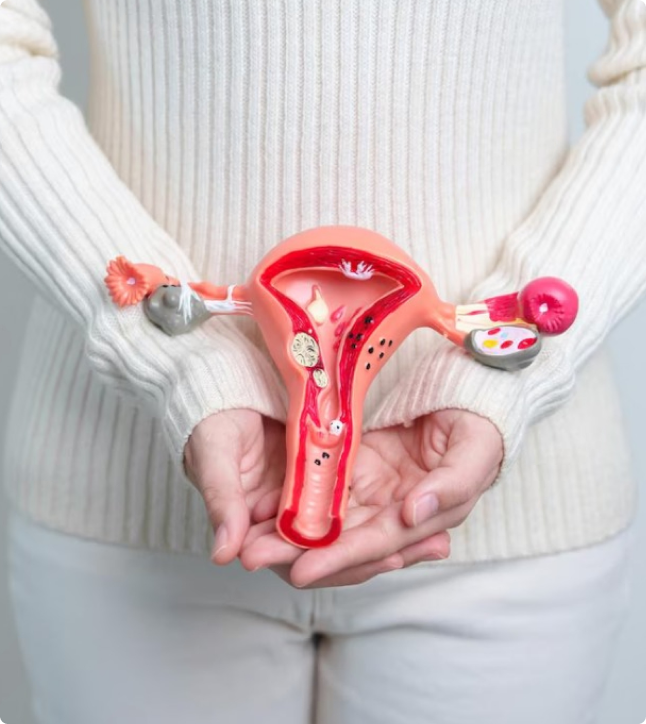Tubal Block Treatment in Chandigarh
- Home
- Tubal Block Treatment in Chandigarh

Tubal Block Treatment
Fallopian tubes, also called as uterine tubes or oviducts, are part of a woman’s reproductive system. These are slender channels that connect the ovaries to the uterus. These tubes are the site of fertilisation, where sperm meets the egg, and then transports the fertilised egg to the uterus for implantation. When these tubes are blocked, pregnancy becomes difficult or impossible by natural means. At Dr. Sabia Mangat’s clinic in Chandigarh, we specialise in Tubal Block Treatment in Chandigarh and help couples improve their chances of natural conception.
Why Are Blocked Fallopian Tubes a Concern?
A blocked fallopian tube prevents sperm and egg from meeting and affects 20–40% of women facing infertility. It is often silent and symptom-free. Many women don’t even know they’re affected until they try to conceive. A blocked tube can also increase the risk of ectopic pregnancy. In this case, a fertilised egg implants outside the uterus, which is a serious health concern. This is why timely blocked fallopian tube treatment in Chandigarh is essential.
Common Causes of Tube Blockage
- Pelvic Inflammatory Disease (PID) – This occurs often from untreated STIs like chlamydia or severe infections
- Endometriosis or pelvic adhesions – A Scar tissue that blocks or constricts the tubes
- Hydrosalpinx – Is a condition where fluid fills the tubes from repeated infections
- Prior surgeries – Such as appendectomy, tubal ligation, or ectopic pregnancy, can leave scars
- Tubal spasm or debris – Can cause mild blockages sometimes due to temporary muscle spasm

Diagnosing Blocked Fallopian Tubes
1. Hysterosalpingography (HSG)
- An X-ray test is performed using dye to check patency.
- It is quick, outpatient and cost-effective. Here, spillage of dye into the pelvic cavity confirms open tubes
- Occasionally, the procedure itself flushes minor blockages, improving fertility for a few months
2. Laparoscopy with Chromopertubation
- It is a minimally invasive ‘keyhole’ surgery done under sedation.
- Here, blue dye is visible strategically to confirm whether the tubes are open
- Also addresses endometriosis, adhesions, fibroids, or hydrosalpinx at the same time.

Treating Blocked Fallopian Tubes in Chandigarh
Treatment depends on the blockage location and severity. It utilises three main avenues:
It is a non-surgical, fluoroscopy-guided procedure. A tiny catheter is used to gently reopen tubes near the uterus. Benefits include:
- Day-care procedure with mild sedation
- High technical success (up to 95%) and 50% pregnancy rate
- Effective for proximal blockages and natural fertility improvement
- Minimal recovery time, usually same-day return home
- Recommended for distal blockages, scar tissue, or hydrosalpinx.
- Repairs may include fimbrioplasty, salpingostomy, or adhesiolysis
- Pregnancy rates range from 15-20 % for carefully selected candidates
- Average recovery of 1–2 weeks due to general sedation
- In cases of severe blockage, bilateral hydrosalpinx, or advanced age
- IVF bypasses tubes completely, fertilising eggs in the lab and transferring embryos directly into the uterus
- If hydrosalpinx is present, removal improves IVF success
Laparoscopic Surgery – How It Heals
When blockages are complex or located toward the ovary (distal tubes), laparoscopy becomes essential:
- This minimally invasive surgery uses a small camera to locate blockages, adhesions, endometriosis, or hydrosalpinx
- It enables real-time therapy and repair, including freeing scar tissue, repairing fimbrial ends, and treating endometriosis in the same session.
- General anaesthesia ensures comfort, while most women return to normal activities within 1–2 weeks.
This gentle, fertility-preserving approach keeps the tubes functional and can restore natural pregnancy potential, without needing IVF.

IVF vs. Tubal Surgery – Choosing the Right Path
- IVF bypasses the tubes entirely. Here, fertilisation occurs in the lab, and the embryo is transferred directly to the uterus. Tubal blockages are no longer a barrier.
- IVF success remains strong in tubal factor infertility, comparable to other causes
- IVF success still drops significantly if hydrosalpinx isn’t treated; removing problematic tubes first can nearly double the odds
- That means tubal ligation isn’t just optional; it can improve outcomes even with IVF.

Prevention & Long-Term Care
At Dr. Sabia’s fallopian tube blockage clinic in Chandigarh, we don’t just fix blockages, we also guide you to prevent them:
- Prevent infections related to STIs or PID. Have safe sex and prompt treatment.
- Treat endometriosis, not just for pain relief but to protect the tubes.
- Avoid repeat pelvic infections, especially after surgery, to prevent new scar formation.
- Maintain a supportive recovery plan. Follow-up HSG scans, early pregnancy monitoring, and emotional wellness support.

Success Rates & Expectations
- Recanalization: 85–95% success in tube patency; 40–60% natural conception
- Surgical Laparoscopy: ~30–45% pregnancy rate, depending on age and damage
- IVF alternative: This is best when the tubes cannot be repaired. Has strong success when hydrosalpinx is treated
Recovery & Follow-up
- Cannulation Recovery
- mild cramping, light spotting
- return to normal within 24–48 hours
- Lap Surgery Recovery
- 1–2 weeks before full activity resumes
- follow-up ultrasound or HSG confirms tube openness
- Monitoring for Ectopic Pregnancy
- Dr. Sabia schedules early pregnancy checks. Treated blockages slightly raise ectopic risk, necessitating prompt detection
At Dr. Sabia’s Fallopian Tube Blockage Clinic in Chandigarh, You’ll Find:
- Clear, compassionate communication in plain language
- State-of-the-art diagnostic and surgical procedures
- Personalised treatment plans, whether non-surgical, surgical, or IVF
- Comprehensive emotional and medical support
- A dedicated team with deep experience in Tubal Block Treatment in Chandigarh

FAQs About Tubal Block Treatment in Chandigarh
Infections, scarring from surgeries, endometriosis, or hydrosalpinx.
Through HSG (a dye test) or laparoscopy with chromopertubation.
Yes, via tubal cannulation, especially effective for proximal blockages.
It’s done under mild sedation; discomfort is minimal.
Slight bleeding, infection, or rare ectopic pregnancy—carefully monitored.
1 day after cannulation; up to 2 weeks after laparoscopy.
Yes, especially if tubes are irreparable or hydrosalpinx is present.
Costs vary by procedure; please contact the clinic for detailed estimates and financing options.
Natural attempts can begin 1–2 cycles post-procedure, after reconfirmation of patency.
Absolutely, Dr. Sabia’s Fallopian Tube Recanalization in Chandigarh is equipped for full tubal blockage care.
Empowering Your Fertility Journey
Discovering that your fallopian tubes are blocked can feel overwhelming, but you’re not alone. With modern, compassionate care from Dr. Sabia Mangat, couples in Chandigarh have real options to restore fertility and begin their families. Whether it’s tubal block treatment in Chandigarh, blocked fallopian tube treatment in Chandigarh, or accessing a high-tech fallopian tubes blockage treatment centre in Chandigarh, our goal is to guide you through every step: diagnosis, treatment, emotional support, and beyond.
Book your consultation today and take the first step toward restoring natural hope for parenthood.
